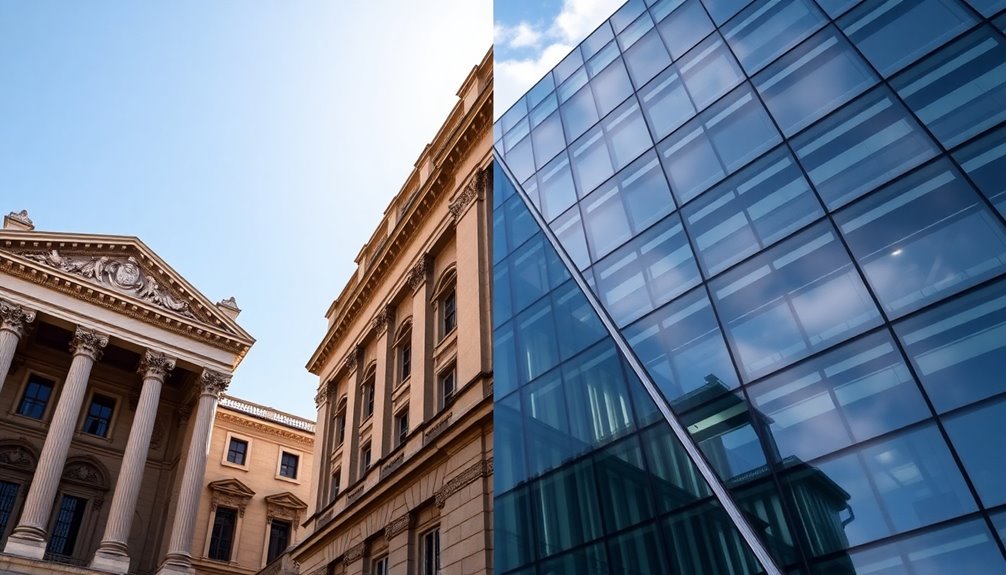Classical architecture, rooted in ancient Greece and Rome, emphasizes symmetry, grandeur, and ornate details. You'll notice its use of proportionality and classical orders, giving structures a sense of stability and order. In contrast, modern architecture focuses on minimalism and practicality, prioritizing clean lines and functional form. These designs rely on industrial materials like glass and concrete, aiming for innovation and energy efficiency. While classical styles evoke historical significance, modern approaches respond to contemporary needs. Each reflects its time's values, shaping how we experience spaces today. Explore further to uncover even more about this fascinating architectural evolution.
Key Takeaways
- Classical architecture emphasizes symmetry, proportion, and ornamental details, while modern architecture focuses on minimalism and functionality with clean lines.
- Classical styles incorporate historical elements and classical orders, whereas modern designs utilize industrial materials like glass, steel, and concrete.
- Monumental buildings in classical architecture symbolize order and stability, contrasting with the open, flexible spaces found in modern architectural designs.
- Architectural fusion blends classical features with modern frameworks, creating designs that honor historical context while meeting contemporary needs.
- Sustainability plays a crucial role in modern architecture, integrating eco-friendly materials and technologies that are less emphasized in classical styles.
Historical Overview of Styles

Throughout history, architectural styles have continuously evolved, mirroring the cultural and technological shifts of their times.
Classical architecture, originating in ancient Greece and Rome, emphasizes symmetry and grandeur, showcasing specific column styles like Doric, Ionic, and Corinthian. These elements define the aesthetic appeal and structural integrity of buildings from this era.
As you move into the early 20th century, modern architecture emerges, marking a significant shift toward minimalism and functionality. This period embraces innovative materials such as glass and steel, prioritizing open spaces over ornate details.
Movements like Bauhaus and the International Style further underscore this transformation, embracing simplicity and industrial design.
Today, contemporary architecture continues to evolve, integrating sustainable practices while acknowledging the lasting impact of its classical roots.
Key Characteristics of Classical Architecture

When you think about classical architecture, notice the striking symmetry and proportion in its design.
You'll find ornate decorative elements that not only enhance the beauty of structures but also reflect a deep sense of harmony.
This combination creates an enduring appeal that continues to influence modern architecture today.
Symmetry and Proportion
Symmetry and proportion stand at the heart of classical architecture, creating a visual language that resonates with harmony and order.
You'll notice that classical structures are meticulously designed with balanced proportions, which evoke a sense of aesthetic pleasure. This is often achieved through mathematical ratios like the Golden Ratio, enhancing beauty in design.
The classical orders—Doric, Ionic, and Corinthian columns—exemplify how essential proportionality is in achieving visual balance. Monumental buildings, such as temples, feature symmetrical layouts that symbolize order and stability.
Additionally, these designs typically revolve around a central axis, amplifying the effect of symmetry and proportion.
Ornate Decorative Elements
Ornate decorative elements define classical architecture, showcasing the artistry and craftsmanship of the era.
You'll notice intricate carvings, friezes, and reliefs, often depicting historical or mythological themes, that elevate the aesthetic appeal. The three primary classical orders—Doric, Ionic, and Corinthian—offer distinct column designs, with the Corinthian order being the most ornate.
Facades of classical buildings frequently feature decorative moldings, pilasters, and pediments, contributing to a sense of grandeur and harmony. These ornate decorative elements go beyond mere beauty; they symbolize cultural values and ideals prevalent in ancient societies.
You'll see their influence in neoclassical movements, which revived and adapted these features across various architectural contexts throughout history.
Defining Features of Modern Architecture

Modern architecture stands out for its commitment to minimalism and practicality, reflecting a philosophy where form follows function. Unlike traditional architecture, which often prioritizes decorative elements, modern designs emphasize clean lines and open spaces. You'll notice the use of industrial materials like glass, steel, and concrete, fostering innovative structures that invite natural light. Additionally, the influence of tropical design elements can be seen in some modern architectural practices, particularly in regions with a focus on blending indoor and outdoor spaces.
| Feature | Modern Architecture |
|---|---|
| Design Philosophy | Minimalism, Functionality |
| Materials Used | Glass, Steel, Concrete |
| Style | International Style |
| Sustainability | Energy-efficient Practices |
| Technology Integration | Smart Building Features |
This approach not only enhances aesthetic appeal but also aligns with contemporary values, making modern architecture a true reflection of today's needs.
Cultural Context and Influences

When you look at architectural styles, you'll notice how deeply they're rooted in their historical and cultural contexts.
Classical architecture embodies the values of ancient civilizations, while modern designs reflect today's societal priorities like functionality and sustainability.
These influences not only shape individual buildings but also define the character of entire communities.
Historical Significance and Evolution
As architectural styles evolved, they reflected the cultural values and societal aspirations of their times. The historical significance of these styles is evident in their evolution from classical grandeur to modern minimalism.
Here are some key points to reflect upon:
- Classical architecture emphasized symmetry and grandeur, rooted in ancient Greece and Rome.
- The Renaissance revived classical principles, showcasing their enduring legacy.
- Modern architecture arose in the early 20th century, prioritizing functionality and simplicity.
- Movements like Bauhaus and the International Style focused on contemporary life and technology.
- The shift from classical to modern highlights a cultural evolution towards innovation and minimalism.
This transformation has profoundly shaped urban design and our built environment, illustrating the dynamic interplay between architecture and society.
Societal Values Reflection
The evolution of architectural styles not only marks shifts in design preferences but also mirrors the underlying societal values at play.
Classical architecture speaks to grandeur and stability, reflecting ancient civilizations' aspirations through its symmetrical designs and ornate details. This emphasis on monumental structures symbolizes civic pride and communal identity.
In contrast, modern architecture, emerging in the early 20th century, prioritizes functionality and simplicity, showcasing a societal shift toward industrialization and innovation. With materials like glass and steel, it embraces technological advancement and creates flexible living spaces.
Curiously, the resurgence of classical elements in modern designs reveals a longing for beauty and tradition, as communities endeavor to balance contemporary efficiency with historical aesthetic values, highlighting the dynamic nature of societal values.
Architectural Fusion and Hybrid Designs

How can architectural fusion and hybrid designs transform our understanding of space? By blending classical elements with modern buildings, you can create spaces that honor history while embracing today's functionality. This approach not only respects the past but also enhances urban aesthetics.
Here are some key aspects of architectural fusion and hybrid designs:
- Combines classical features like columns with modern frameworks
- Creates a dialogue between past and present architectural philosophies
- Requires careful planning for visual cohesion
- Promotes architectural diversity that resonates with community preferences
- Fosters thoughtful integration in urban settings
Notable examples, like the Louvre Pyramid, showcase how successful fusion can harmoniously unite different styles, enriching our architectural landscape.
User Engagement and Community Impact

Architectural fusion not only enhances aesthetics but also deepens user engagement and community impact.
When you incorporate classical elements into modern designs, you tap into cultural nostalgia, fostering emotional connections to the past. Many people prefer classical architecture for its historical significance, making it essential to take into account these preferences in urban planning.
By blending styles, you create cohesive environments that resonate with local identities, addressing public dissatisfaction with the blandness of modern architecture. Engaging your community in architectural decisions encourages ownership of public spaces, fostering appreciation for diverse designs.
Ultimately, when you honor local heritage while embracing modern functionality, you enhance user engagement and contribute positively to the community's overall impact. Additionally, assessing client needs is crucial in ensuring that architectural designs reflect the desires of the community.
Future Trends in Architectural Design

As sustainability becomes more essential in design, future trends in architecture are shifting towards eco-friendly materials and energy-efficient systems.
You'll see a fascinating blend of classical elegance with modern style, resulting in hybrid designs that honor historical context while meeting contemporary needs.
Here are some key trends to watch:
- Use of sustainable, eco-friendly materials
- Integration of smart technologies for enhanced energy efficiency
- Development of responsive architecture that adapts to user needs
- Emphasis on community engagement and inclusivity in design processes
- Creation of versatile spaces that accommodate various functions
These trends reflect a commitment to reducing environmental impact while ensuring that architecture resonates with the communities it serves. Additionally, the incorporation of eco-friendly materials is becoming increasingly vital in both tropical and contemporary architecture.
Embrace the future of architectural design!
Frequently Asked Questions
What Are the Key Differences Between Classical and Modern Architecture?
When you compare classical and modern architecture, you'll notice several key differences.
Classical architecture emphasizes grandeur and symmetry, often featuring ornate details and historical elements like columns.
In contrast, modern architecture focuses on minimalism and functionality, using advanced materials like glass and steel.
You'll also see that classical designs evoke historical significance, while modern styles prioritize sustainability and innovative design, creating adaptable spaces that suit contemporary needs.
What Is the Difference Between Modern Architecture and Traditional Architecture?
When you compare modern architecture to traditional architecture, you'll notice distinct contrasts.
Modern architecture emphasizes minimalism and functionality, using materials like glass and steel for open spaces.
In contrast, traditional architecture showcases craftsmanship, elegance, and historical styles, often featuring intricate details with brick and timber.
While modern designs focus on efficient layouts, traditional homes offer distinct, larger rooms that reflect cultural heritage and nostalgia, creating a unique atmosphere you can appreciate.
What Is the Difference Between Traditional and New Architecture?
Did you know that over 70% of people prefer traditional architecture for its charm?
When you look at traditional architecture, you'll notice its focus on historical styles, symmetry, and craftsmanship. In contrast, new architecture emphasizes minimalism and functionality, often using modern materials like glass and steel.
Traditional designs typically include distinct, larger rooms, while new architecture favors open-concept layouts that maximize space and utility for contemporary living needs.
What Are the Differences Between Modern Buildings and Traditional Buildings?
Modern buildings and traditional buildings differ considerably in design and materials.
You'll notice that modern structures often embrace large windows and open spaces, creating an airy atmosphere, while traditional buildings typically feature smaller, symmetrically placed windows and intricate details.
With regard to layout, modern spaces promote flexibility with open-concept designs, whereas traditional buildings have defined rooms and elaborate arrangements.
Ultimately, these differences reflect evolving societal needs and preferences in architectural style.
Conclusion
As you explore the world of architecture, you'll notice classical structures stand tall with their ornate columns and grand symmetry, while modern designs embrace minimalism and open spaces. This juxtaposition highlights how history informs innovation, creating a dialogue between the past and the present. Both styles, rooted in their cultural contexts, inspire creativity and offer a glimpse into future trends. By blending elements of both, you can envision spaces that resonate with community and individuality alike.









